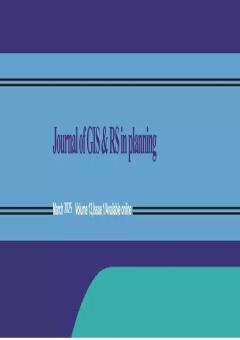Locating new sports facilities based on environmental criteria using GIS
Subject Areas : Environmental planning
1 -
Keywords: Keywords: Sports facility location, air pollution, environmental, GIS.,
Abstract :
The aim of the present research was to locate a new sports facility based on environmental criteria using GIS maps. Method: This study was applied in nature and cross-sectional in terms of the time of execution. The data collection method was a mixed approach (library and field). The duration of the research was two years (2021-2022). Geographic layers at a scale of 1:25,000 were obtained from the Geographic Organization of Armed Forces and the Semnan Governorate with an introduction letter from the university. The research team consisted of 28 experts in urban management, geography, urban planning, sports management, architecture, urban design, and urbanism. Effective indicators for optimal location of sports facilities based on environmental criteria in cities were identified. Additionally, to overlay the layers and location criteria, ArcGIS software version 9.2 was used. Findings: According to the results obtained and based on environmental factors such as distance from roads, existing sports complexes, industrial areas, elevation, pollution, AOD levels, wind speed in the area, and proximity to the city center, approximately 5.36 square kilometers in the city had high value for establishing a new sports complex, followed by 12.02 square kilometers in second place. Conclusion: Air pollution negatively impacts quality of life, and outdoor exercise can reduce depression and stress, but it increases the risk of exposure to pollutants. The combination of exercise and air pollution can disrupt health and athletic performance. Industrial areas and aerosol optical depth (AOD) are primary factors of pollution, and using remote sensing data is effective for identifying pollution.
Akhtar, G., Hematinezhad, M., Mohammadi, S., & Jolandan, M. J.(2020). Locating Sports Facilities in City of Talesh by Using AHP in the GIS Environment.
Mohammed, H. R. (2021). Determination of Suitable Areas for Establishment of Sports-City in Iraq's Center Using an Integrated Fuzzy Logic Algorithm and Geomatic Techniques. Engineering and Technology Journal, 39(8), 1291-1300.
Tan, X., Guo, C., & Sun, P. (2023). Study on rationality of public fitness service facilities in Beijing based on GIS. Sustainability, 15(2), 1496.
Wen, H., Chen, S., Lai, J., & Wang, J. (2023). Study on the Optimization of Spatial Layout of Public Sports Facilities in Urban Communities—A Case Study of Xiangshan Street Community in Shenzhen. Frontiers in Sport Research, 39-46.
Soczówka, P., Lasota, M., Franke, P., & Żochowska, R. (2024). Method of determining new locations for electric vehicle charging stations using GIS tools. Energies, 17(18), 4546.
Shafii, M., Afrazandeh, S. M., CharRahi, Z., Al-Modaresi, S. A., & Askari, R. (2023). The Optimized Location of Hospitals Using an Integrated Approach GIS and Analytic Hierarchy Process: A Case Study in Iran. Iranian Journal of Health Sciences, 11(3), 195-206.
Sui, D. Z., Elwood, S., & Goodchild, M. F. (2013). Crowdsourcing Geographic Knowledge: Volunteered Geographic Information (VGI) in Theory and Practice.
Levin, N., & Lechner, A. M. (2017). The role of GIS in environmental management. Environmental Management, 60(2), 215-227.
Salimi, M., & Khodaparst, M. (2021). Providing the optimal method for sport places site selection based on GIS analytic functions. Journal of Facilities Management, 19(3), 339-357.
Ahmadi, A., Honari, H., Shahlaee, J., Kargar, G., & Ghafouri, F. (2021). Designing a model for optimal locating of sports facilities based on the urban planning criteria. Sport Sciences and Health Research, 14(2), 161-171.
Xu, L., & Lyu, G. (2022). Influence of urban atmospheric ecological environment on the development of outdoor sports. Mathematical Problems in Engineering, 2022(1), 1931075.
Hemati, M. A., Taji, A., Hojabri, K., & Sori, A. (2019). The Survey Geographical Location of Sports Facilities by Using GIS (Case Study: Rasht). Sport Management and Development, 8(2), 41-50. APA.
da Fonseca Cruz, F. (2020). Planning Sports Facilities Based on a Multicriteria Model Built in GIS Environment. Journal of Civil Engineering and Architecture, 14, 409-426.
Salimi, M., & Khodaparst, M. (2021). Providing the optimal method for sport places site selection based on GIS analytic functions. Journal of Facilities Management, 19(3), 339-357.
Gao, J. (2018, December). The layout and Material Development of Sports Facilities based on GIS in Tibetan Plateau Environment in Gansu Province. In IOP Conference Series: Earth and Environmental Science (Vol. 208, No. 1, p. 012103). IOP Publishing.
Tayebi Sani, Seyed Mostafafi, Taqvi, Farzaneh, Ayder, Nabiullah, Khojo, Mozhdeh. (2022). .Investigating the impact of sports spaces on urban environments using the Geographic Information System (GIS). Application of Geographic Information System and Remote Sensing in Planning, 3 (12). ,63-75.
Mollaei, Azam, Karkeabadi, Zeinab, Arghan, Abbas. (2022). .Developing branding strategies based on physical and environmental dimensions of a smart city in the sixth district of Tehran, Yousef Abad neighborhood. .Application of Geographic Information System and Remote Sensing in Planning, 4 (14), ,50-63.
Hemmati Nejad, Mehr Ali; Taji Findari, Ahmad; Hejabari, Kazem; Souri, Abuzar. (2018). Investigating the geographical location of sports venues using the Geographic Information System (GIS) Case Study: Rasht City). Sports Management and Development, 8(2), (18th issue), 143-157.

